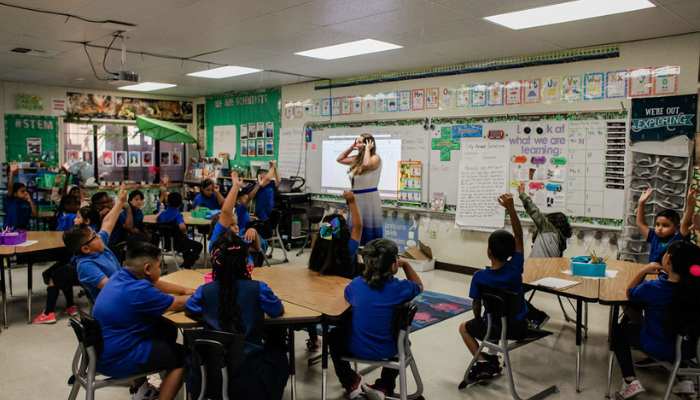
A special education classroom plays a critical role in empowering students with diverse learning needs to thrive academically and socially. Designed to support learners with disabilities or special challenges, these classrooms are more than just spaces—they are carefully curated environments that foster growth, confidence, and inclusion. Whether you’re a new teacher, parent, or education professional, understanding the nuances of a special education classroom can make a meaningful difference in student success.
In this article, we’ll explore what makes a special education classroom truly effective, how to design one that supports every learner, and practical strategies for teaching and managing students with special needs. From classroom layout ideas to behavior management tips, this comprehensive guide is packed with valuable insights to help you create an inclusive and productive learning environment.
What Is a Special Education Classroom?
A special education classroom is a structured learning environment tailored to meet the unique educational needs of students with disabilities. These classrooms are staffed by trained special education teachers who are skilled in modifying curricula, using individualized instruction, and implementing accommodations or supports outlined in a student’s IEP (Individualized Education Program). The primary goal is to help students achieve their full academic potential while nurturing social-emotional development.
Unlike general education classrooms, special education settings offer smaller class sizes, specialized equipment, and adaptive teaching methods. These features allow educators to provide focused attention, personalized interventions, and a supportive atmosphere that encourages learning at every ability level. The design and structure of a special education classroom must align with both the student’s specific needs and federal education standards such as IDEA (Individuals with Disabilities Education Act).
Designing an Effective Special Education Classroom
Creating a successful special education classroom setup starts with understanding the sensory, cognitive, and emotional needs of the students. The classroom should be a calm, welcoming space with designated zones for learning, sensory breaks, group work, and one-on-one instruction. Using visual schedules, labeled stations, and color-coded materials helps students stay organized and reduces anxiety.
In addition to furniture arrangement, lighting and sound levels are critical. Soft lighting, noise-dampening materials, and flexible seating options like beanbags or standing desks can support students with sensory sensitivities. Safety must also be prioritized—furniture should be secure, transitions smooth, and any potential hazards removed. Incorporating technology such as speech-to-text tools, adaptive keyboards, and tablets ensures accessibility and enhances learning for students with various challenges.
Teaching Strategies for the Special Education Classroom
Effective teaching in a special education classroom involves using differentiated instruction and multi-sensory learning techniques. This means adapting lessons to include visual, auditory, kinesthetic, and tactile components, so that every student can engage in a way that suits their learning style. Teachers must also scaffold content—breaking lessons into smaller, manageable chunks and offering step-by-step guidance.
Another key strategy is frequent positive reinforcement. Praise, rewards, and consistent encouragement help build student confidence and reinforce desired behaviors. Special education teachers also rely on evidence-based programs such as Applied Behavior Analysis (ABA), PECS (Picture Exchange Communication System), and social stories to support communication and behavior development. Collaboration with occupational therapists, speech therapists, and counselors ensures that all aspects of a student’s growth are addressed holistically.
Classroom Management and Behavior Support
Behavior management is an essential part of running a successful special education classroom. Students may exhibit a wide range of behaviors due to sensory processing disorders, emotional regulation difficulties, or cognitive delays. Establishing clear routines and consistent rules from day one sets expectations and provides a sense of structure.
Behavior intervention plans (BIPs) are commonly used to address challenging behaviors. These individualized plans outline triggers, behaviors, and responses, ensuring consistency among all staff. Using tools like token economies, behavior charts, and calming corners provides students with constructive outlets and encourages self-regulation. Most importantly, teachers must remain patient, observant, and compassionate, adjusting strategies as needed to suit individual students.
Building Inclusion and Peer Relationships
A well-rounded special education classroom doesn’t only focus on academics—it also nurtures social skills and peer relationships. Building inclusion means creating opportunities for students to interact with peers both within and outside of the special education setting. This can involve buddy programs, peer mentoring, and integrated classroom activities.
Teaching social skills explicitly—such as turn-taking, making eye contact, or understanding emotions—can be done through role-playing, games, or social stories. Creating a classroom culture that celebrates diversity and promotes empathy helps students develop a strong sense of self-worth and belonging. When students feel understood and included, their motivation and participation naturally increase, setting the stage for long-term success.
Conclusion
A special education classroom is a vital cornerstone in the landscape of inclusive education. These classrooms are designed not just to teach, but to empower—equipping students with the tools, strategies, and support they need to succeed in school and beyond. From thoughtful design to adaptive teaching strategies and compassionate behavior management, every element plays a role in building a thriving learning environment.
By embracing flexibility, creativity, and a deep understanding of individual student needs, educators and caregivers can transform a classroom into a space where all learners feel valued, supported, and capable. Whether you’re setting up a classroom, supporting a student, or learning more about special education, remember: every child has potential, and every classroom can be a space where that potential is realized.
Frequently Asked Questions (FAQs)
1. What is the purpose of a special education classroom?
The purpose is to provide tailored instruction and support for students with disabilities to help them succeed academically and socially.
2. What types of disabilities are supported in special education classrooms?
These classrooms support a range of disabilities including autism, ADHD, learning disabilities, physical impairments, and emotional disturbances.
3. How is a special education classroom different from a general education classroom?
It typically has smaller class sizes, individualized instruction, and specialized teaching tools to accommodate different learning needs.
4. What qualifications do special education teachers need?
They must have a degree in special education and often hold specific certifications or licenses based on local education laws.
5. How can parents support their child in a special education classroom?
By maintaining open communication with teachers, reinforcing learning at home, and participating in IEP meetings.
6. What role does an IEP play in a special education classroom?
An IEP outlines the student’s learning goals and the specific services and accommodations they’ll receive in the classroom.
7. Are students in special education classrooms isolated from general education peers?
Not necessarily. Inclusion programs allow for shared activities and integration when appropriate for the student’s needs.
8. What classroom tools are useful in special education settings?
Visual aids, sensory tools, adaptive tech, and communication devices are often used to enhance learning and accessibility.
9. How is progress measured in a special education classroom?
Progress is tracked through assessments, observations, and IEP goal evaluations, with regular updates provided to parents.
10. Can students transition from special education to general education classrooms?
Yes, with improvement and support, some students may gradually integrate into general education settings over time.







